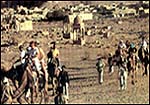

|
|
|
|
| HOME | TRAVEL | TRAVELOG | |||
 Through the Sands of Time ... Jaisalmer
Anvar Alikhan
According to mythology, after the epic battle of the Mahabharat, Lord Krishna and Bhima came here for a ceremony. Looking around him, Lord Krishna prophesied that a descendent of his Yadav clan would some day establish a glorious kingdom here. Then with his discus, he smote a rock and a sweet water spring immediately burst forth. In 1156, this prophecy came true when a young Yadav prince, Rao Jaisal set up a kingdom here and became the first of many, many generations of maharawals. Jaisalmer owed its existence -- and prosperity -- to the fact that it was located on the route of the great camel caravans that came in from Egypt, Arabia, Persia, and Central Asia, carrying their wares to the emporia of Delhi in the east and Gujarat in the south. For nearly 700 years, it was a flourishing trading post for splendid carpets from Herat, scimitars from Damascus, stallions from Arabia, wines from Zhiraz and green-eyed Circassian maidens bound for the harems of Hindustan. A persistent -- but untrue-- legend even holds that Marco Polo stopped off here on his way to China.
In fact, it was so cut off from the world and its ways that as late as the 1940s the Maharawal of Jaisalmer was still building desert fortresses to defend his kingdom -- just 30 years before a nuclear device was tested at Pokharan, 50 miles away. Yet, it is ironic to think that for a brief moment in the early 19th century, this dusty, medieval little town had become a hot spot of international geopolitics. It was the time when the Russian empire was looking covetously at the warm water ports of the Indian Ocean. British intelligence suddenly learned that the Russian plan was a send its armies into India by way of Jaisalmer - and therefore securing the town became of prime strategic importance to the British. Then gradually the Russian threat receded, and Jaisalmer was forgotten once again for a century and a half.
When Satyajit Ray saw it, he was inspired to make a film called Sonar Kellar or The Golden Fort, a charming fantasy about a treasure guarded by a peacock. The fort stands on a hill 250 ft high, enclosed by a thick, crenellated wall, punctuated by 99 bastions. Remarkably, these walls used no mortar at all; they were made entirely from huge blocks of stone that interlock ingeniously with each other. Much of the town still lives within the fort's 12th century walls, making it a kind of living museum. Walking through it -- at night particularly -- is an eerie experience.
|
|
|
Tell us what you think of this feature
|
|
|
HOME |
NEWS |
BUSINESS |
CRICKET |
MOVIES |
CHAT
INFOTECH | TRAVEL | LIFE/STYLE | FREEDOM | FEEDBACK |
|